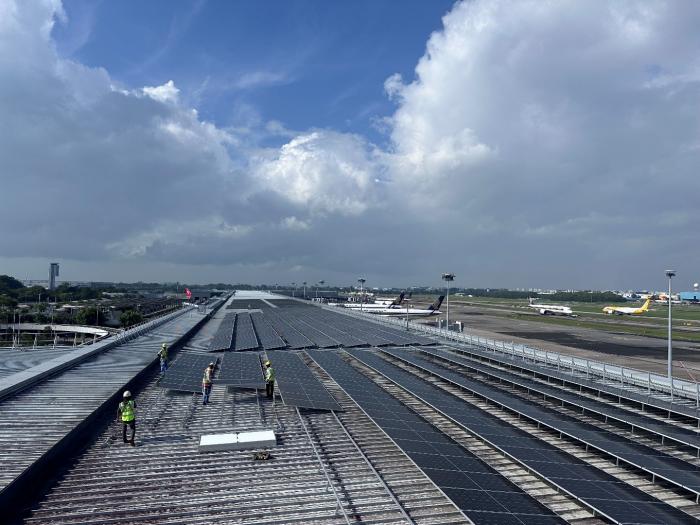The system of solar panels will be spread across terminal buildings, terminal auxiliary structures, airfield and cargo buildings, with Keppel contracted to operate it for 25 years. When completed in early 2025, the solar PV system will have a combined generation capacity of 43 mega-watt peak (MWp), 38MWp of which will be installed on rooftops, making this Singapore’s largest single-site rooftop solar PV system.
The remaining 5MWp of solar generation capacity will come from a solar PV system installed on a 40,000m2 turf area within Changi Airport’s airfield, outside of aircraft operational areas. This will be the first time a solar PV system has been installed on the airfield, marking the first step towards maximising solar potential at Changi Airport beyond conventional rooftop spaces.
The new system will enable Changi Airport Group (CAG) to reduce its carbon emissions by approximately 20,000 tonnes each year, which represents approximately 10% of its 2019 consumption.
The challenges of PV systems
According to CAG, deploying solar PV systems in the airport involves a set of unique challenges when compared to conventional installation at commercial, industrial, or residential sites. For example, robust simulation had to be carried out to ensure that the solar panels do not pose glare and glint effects to air traffic controllers and pilots or interfere with communications, navigation & surveillance (CNS) and meteorological signals. The associated installation and maintenance processes will also need to comply with aviation safety and security requirements, including fire safety code requirements prescribed by the Singapore Civil Defence Force.
The completed PV system will be integrated with Keppel’s state-of-the-art operations nerve centre (ONC) sited within the Keppel Infrastructure@Changi building, which will offer remote monitoring and real-time reporting of solar generation metrics as well as advanced fault detection and diagnostics for predictive maintenance, all of which ensure high system up-time and optimal power generation. Keppel’s ONC also deploys artificial intelligence and machine learning algorithms to form adaptable models for better forecasting and energy management to optimise asset performance and operational outcomes.
Koh Ming Sue, CAG’s executive vice president, engineering & development, said of the project: “Notwithstanding Singapore’s limitations with renewable energy sources, CAG strives to make Changi a more sustainable aviation hub through reducing carbon footprint from all practical fronts. We have been addressing the airport’s energy demands at its core, which includes upgrading our frontline airport building and systems with best-in-class energy efficient models and expanding our support for the airport community to switch to cleaner energy vehicles. Partnering Keppel in this project, which is Changi Airport’s largest deployment of solar PV system to date and our first foray into solar PV systems in the airfield, we have taken a significant step forward in our decarbonisation journey.
He added: “In parallel, at the back end, CAG has appointed another partner, SolarGy, to transform our airport maintenance and storage centre into a greener facility by installing a 640kWp rooftop solar PV system which will cut the facility’s emissions by around 50%. As technology continues to advance, we look forward to working with innovative partners to further unlock solar potential and other sustainable opportunities at Changi Airport.”

